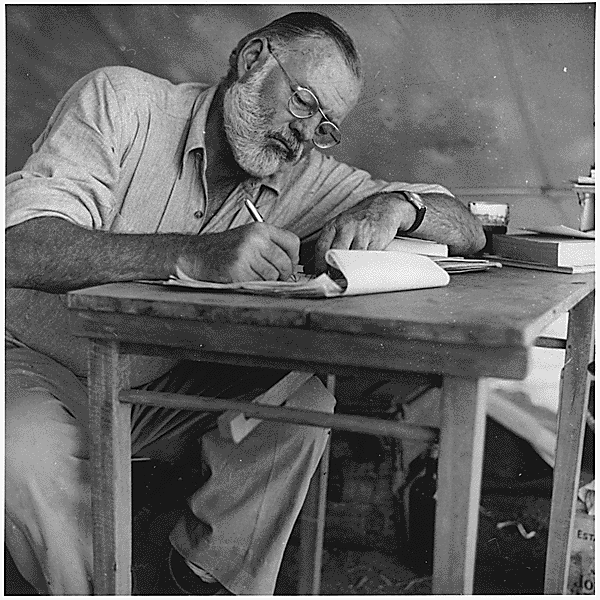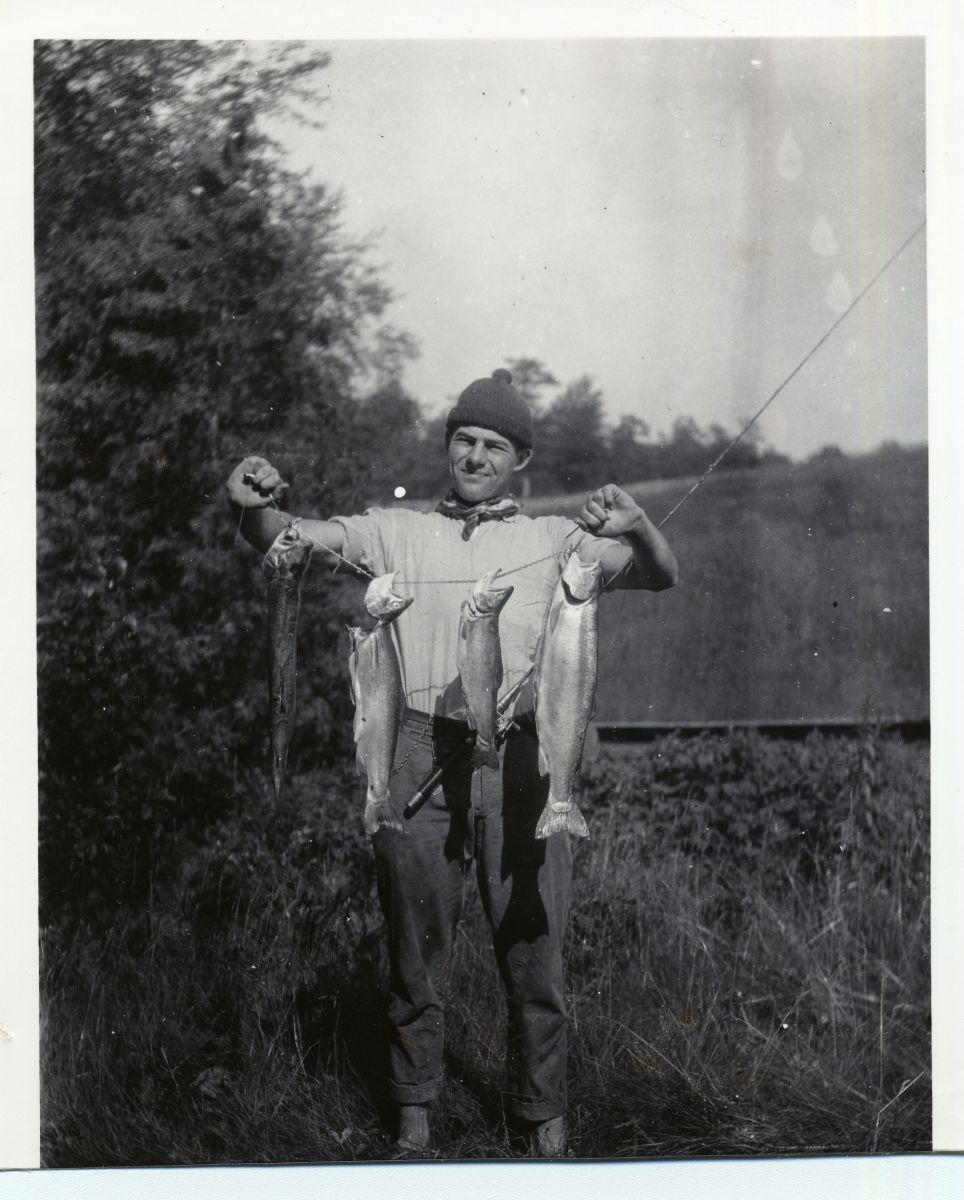
- He met us in the Sanfermines of 1923 and a year later he went to Irati for rest. Baiona, Garazi, Donostia, Iruñea, Gernika, Bilbao... has been one of the literary references he has had in his works. This month of July 100 years ago he met the Irati River and the forests and corners of the area, and later he would become our usual visitor. The stay in Irati covers several passages in the novel Fiesta (Festa) that he published in 1926.

The conference will be held at Kursaal in Donostia and at the Hotel Carlton in Bilbao from 14 to 20 July. EH and EH – Ernest Hemingay and Euskal Herria-, Ernest Hemingway conference. A small meeting will also be held at Auritz/Burguete, at the Orbaizeta factory and between Aribe on 28 July: Ernest Hemingway and Irati.
Iñaki Sagarna has been, since the beginning, historian and professor in the organization of the conference EH and EH: “It is the last link of a great cluster of coincidences to have held the congress in the Basque Country. It all started in 2019, when I had just finished my master’s degree in Boise and the Idaho Community Library Association offered me a three-month scholarship at Ketchum.” The association manages the house in which Hemingway committed suicide, and the scholarship received by Sagarna was intended in principle to classify or investigate the objects left in his house. “At first I thought I would only do a job of cataloguing objects. However, as soon as I got there, I realized that in Idaho, the relationship between Hemingway and the Basques there was nothing studied. They authorized me to replace the cataloging with this research. Before I finished my three-month stay, I discovered about twenty relationships between the Basques of Idaho and Hemingway,” says Sagarna. Before he began to investigate the relationship between the Basques and the writer Hemingway, he contacted Edorta Jimenez and Javier Muñoz, who were already working on the Basque Route project.
Jimenez has also been researching and writing about the relationship between Hemingway and the Basques for some time. He published the book Hemingway eta euskaldunak zerbitzu sekretuak with the editorial Susa and the book SanFermingway with the Txalaparta. Jiménez talks about this when he asks about the subject: “The presentiments I had when I started this topic seem to have been, in the end, correct. The most outstanding witness has been the exhibition Hemingway and Euskal Herria. Sagarna and I made it at the Museo Euskal Herria de Gernika-Lumo. He has then walked around, and this summer he is in San Sebastian, taking advantage of the annual congress of the Hemingway Society to be held there and in Bilbao.” Jiménez says that what Sagarna has found both in the archives of the United States and in the archives here are important.
Iñaki Sagarna, historian: "That Hemingway that accompanied us in the 1920s and 1930s was really a productive writer."
Sagarna participated as a speaker at a conference organized in the United States. The organizers liked it and this relationship has now come about the fact that it has embarked on a meeting as international as that of Donostia and Bilbao. Sagarna has validated these congresses: “In addition to the academic framework, it is a congress of great social weight; I have had to arrange about five large meals, two or three 250 people, and a couple of concerts.” In the Kursaal and the Carlton Hotel, lectures of 180 researchers and writers, an exit to the Rioja Alavesa, a basket game at the fronton Deportivo de Bilbao, and the first day of the conference in verses of Amets Arzallus and Maialen Lujanbio with simultaneous translation of Xabi Paya from Basque to English.
.jpg)
Basque writers have
also participated in the conference at this international conference. And they've participated in Euskera. Edorta Jimenez and Josu Jimenez Maia were at a round table. The first spoke of Hemingway and Gernika, while the second, translator and poet, focused on Heminway poetry. Ibai Iztueta compared the works of Pius Baroja and Hemingway and Kirmen Uribe chose the passages of the book Elkarrekin esnatzeko ordua (time to wake up together), where, among other topics, he spoke about the correspondence between Manu de la Sota and Ernest Hemingway. For his part, the professor of the UPV/EHU David Rio made a comparison of the works of Robert Laxalt and Hemingway. Following the Anglo-Saxon language, the Basque language has been the second most important language of the congress. That doesn't always happen.
Edorta Jimenez gave us a summary of his speech in four words, which he hopes to publish later: “Ernest Hemingway was not in Gernika on the day of the bombing and yet collected direct and rich information about him; among other things, we count on the testimony of his witnesses. Andrés Untzain, for example, was there. Martha Gellhorn, Hemingway’s third wife, also tried to inform the world of what happened in Gernika.”

The stereotypes we have about Hemingway also question
Josu Jimenez Maia by breaking stereotypes: “We always imagine drunks in sanfermines, alcohol abuse... and I think there is another Hemingway as unknown as interesting to understand its literature and its character well.” In his words, it is essential to be aware of the times that Hemingway spent in Irati, to know his walks, his landscapes, his experiences and his friends. “On the eve of Sanfermin, the image of Hemingway that most media transmit to us is always full of stereotypes, quite commercialized, that foster consumerism. And I've been more interested in Hemingway from the point of view of literature."
Edorta Jimenez also complains that we ask how we know the writer Hemingway here: “The fatal fate of that Hemingway. He massified the Sanfermines, which was actually a name, by the way. In Nafarroa Garaia, who has read the book Fiesta? Who knows what you wrote about Donostia? Or the woolly summer, the last one he wrote, that starts in Bilbao? Or that ‘these Basques are wonderful’ he wrote about the mountaineers of Navarre and not about the Basques of Bizkaia, Gipuzkoa or Álava. The best known is, however, Ernest Hemingway II. He was a friend of the Republic and all anti-fascists.” Edorta Jiménez speaks clearly, with correction, without beard; researching, deepening and reading a lot, and later also written.
For Sagarna, too, the image they have sold us from Hemingway and what he has known are very different. “Hemingway was much more than an old brown, old, drunk, party lover… that Franco wanted to sell. Unfortunately, only that image of Hemingway that was forged throughout Franco’s time has arrived in our surroundings, but the Hemingway that travelled around the 1920s and 1930s was a real productive author.” Sagarna adds that it does not read much, with a certain anger: “At least the names of the novels are known. But he was a great storyteller, more than a good novelist.” Fortunately, in 2011 Xabier Olarra translated some of his stories to the Basque, and Koro Navarro, Fiesta: The sun also rises last year.
After World War I, Hemingway became a fierce rival to the war. Sagarna stresses that this can be clearly seen in A Farewall to Arms and in some of the poems he wrote, some of which have already been translated into Basque by Josu Jiménez Maia. Although he rejected the war at the time of interwar, Sagarna assured that he saw that in the war in Spain fascism had to be fought: “This can be a good learning for our learning.” Furthermore, it points out that: “There are many people who believe that Hemingway is a symbol of American imperialism, but it is not, contrary to what is believed. He was very critical of the United States Government, for example, and publicly stood in favor of the Cuban revolution in the years leading up to death.”

Chained by the
narrative, Josu Jiménez Maia admits that Hemingway's stories caught him. Francis Macomber and other stories, edited by the editorial Igela, enjoyed the life of Berriozar’s neighbor: “For me they were a discovery, Hemingway brought other kinds of literature. Suggestive, short sentences, few subordinate, correct phrases that count a lot.” Then he came to poetry. “He didn’t write many poetry, but those 88 poems written throughout his life give us a lot of experience about his narrative and his life.” Josu Jimenez Maia translated several poems from Ernest Hemingway into Basque and published them in Maiatz magazine. In July of this same year, coinciding with the Hemingway trip, he put them on the literary network Armiarma.eus.
Edorta Jimenez has also been behind Hemingway in many parts of the world, from Urdaibai to Cuba, among others. “I brought from the United States an unforgettable image of the Nevada sky. And very high knowledge of the university system. I also knew the world of the Basques there. Mostly they welcomed me at home by Joe Gerrikagoitia and his wife Hellen.” Also memories from other places: “When I first went to Cuba before Nevada in 2000, I met Joseba Sarrionandia and other hostels. It was a profound experience to know the lives of our people there. I went to Cuba on other occasions, both to investigate and to visit my friends.”
"We always imagined it drunk in sanfermines, but there's another Hemingway as interesting as unknown."
What about Cuba? “Once I leave and come back with an opinion, again I leave and go back with another opponent, I don’t know that now I am able to make a balance. I’m not going to try,” concludes Edorta Jimenez, as if he wanted to move away from the subject.
The meeting in Irati, which
will witness the Donostia and Bilbao Conference, will be the meeting of Irati. The events will be held at the Kultur Ola, in collaboration with the Ateneo Cultural de Navarra.
On 28 July, in the morning, Victoriano Urdiroz, who was head of the Hotel Burguete, will first be honoured. Then they will make a walking tour from Auritz/Burguete to the Orbaizeta factory, reading on the way passages from the book Fiesta. In Orbaizeta, the Hemingway fountain will have an image in his honor, and after the meal will be offered lectures by Iñaki Sagarna, Edorta Jiménez, Ibai Iztueta and Cira Crespo. At dusk, at the hand of the poetry group Joxe Miel Bidadores, the poem of Hemingway will be read in the immediate vicinity of the Aribe spa, on the banks of the Irati River. Starting in the fall, the group of readers who meet each month with the writer Auzperrin Mikel antza will talk about the book Fiesta: eguzki levantatzen da.
[Also read the following two articles: Interview with Koro Navarro, translator of the Hotel Burguete, witness of the Francoist repression and the book Fiesta.]